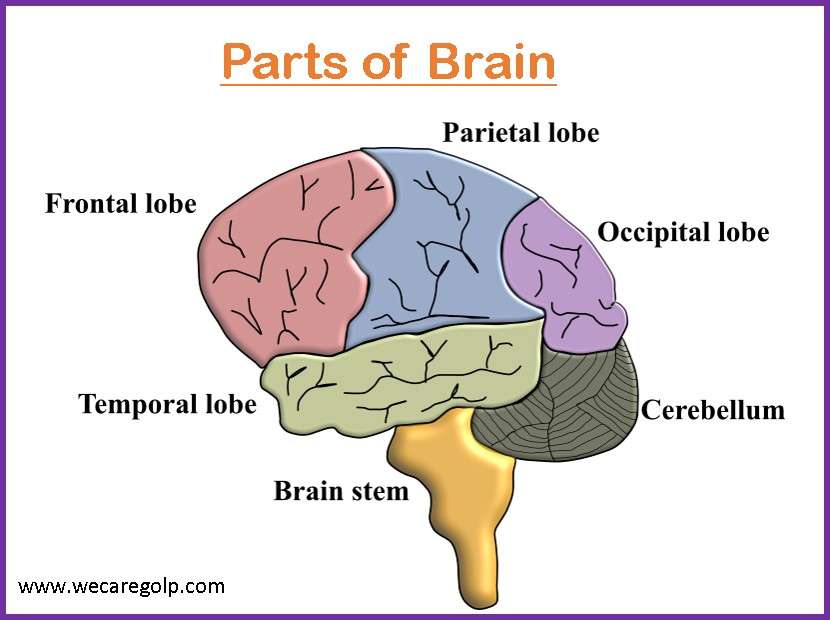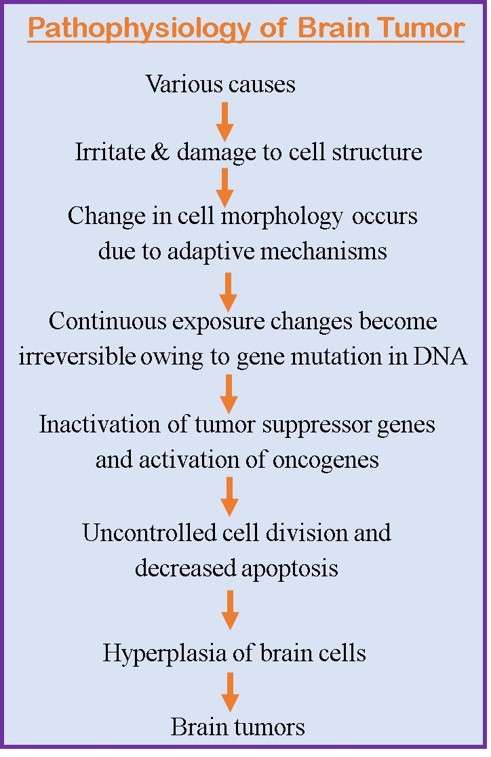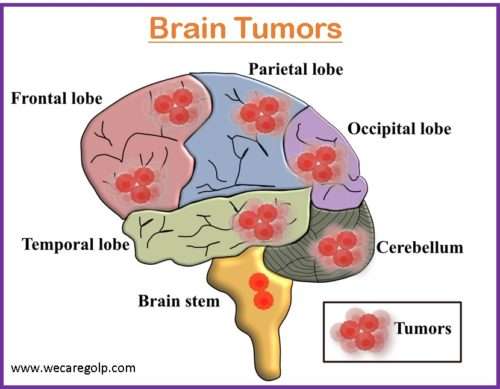Introduction
A brain tumor is the growth of abnormal cells in the brain or other parts of the central nervous system (CNS), such as the spine or cranial nerves. Some tumors are malignant (cancerous), while others are benign (non-cancerous).
- Primary tumors are categorized as glial (composed of glial cells) or non-glial (developed in the structures of the brain, including nerves, blood vessels, and glands), and benign or malignant.
- Metastatic brain tumors, also known as metastases, are cancerous tumors that have spread to the brain from another part of the body (colon, lungs, or breasts) to the brain. On the other hand, primary brain tumors emerge in the brain and most of them are benign.
Click here to understand the medical terms.
Epidemiology
According to International Agency for Research in Cancer, World Health Organization 2020, all cancer cases except non-melanoma skin cancer are 9,894,402. Among them Brain & CNS cancer:
- Incidence 308,102 (3.11%)
- Prevalence 837,152 (8.46%)
- Mortality 251 329 (2.24%)
Types of Brain Tumor
- Gliomas, glioneuronal and neuronal tumors: Glioma is a tumor that arises from the supportive (gluey) tissue of the brain or spinal cord, whereas neuronal tumors arise from cells with neuronal differentiation. Glioneuronal tumors are a mixture of neuronal and glioma brain tumors.
- Choroid plexus tumors: A choroid plexus tumor is a rare cancerous tumor that begins near the brain tissue that secretes cerebrospinal fluid. It is common in children.
- Embryonal tumors: Embryonal tumors of the CNS are malignant tumors that originate in the fetal (embryonic) cells in the brain and are most common in babies and young children.
- Pineal tumors: A pineal tumor is a rare tumor of the pineal gland that makes melatonin (a substance that regulates our sleep-wake cycle). This tumor is common in children and young adults.
- Cranial and paraspinal nerve tumors: This group includes schwannoma, neurofibroma, perineurioma, hybrid nerve sheath tumors, and malignant peripheral nerve sheath tumors. The tumors are usually benign, slow-growing neoplasms composed of one or more elements of a nerve cell.
- Meningiomas: A meningioma is a tumor that arises from the meninges (membranes that surround the brain and spinal cord).
- Mesenchymal, non-meningothelial tumors involving the CNS: Primary mesenchymal tumors of the CNS are rare and comprise a diverse group of entities like Fibroblastic and myofibroblastic tumors: solitary fibrous tumors, Vascular tumors: hemangiomas, vascular malformations, and hemangioblastoma, etc.
- Melanocytic tumors: Melanocytic tumors are derived from melanocytes (the cells that give the skin its brown color) that migrate during embryogenesis and populate the skin as well as mucosal surfaces, the urogenital tract, and the leptomeninges (the inner two meningeal layers—arachnoid and pia)
- Hematolymphoid tumors involving the CNS: Hematolymphoid tumors represent a primarily, but not exclusively malignant cohort of tumors that are commonly diagnosed in the head and neck. E.g., Extranodal Natural Killer/T-cell lymphoma and extraosseous plasmacytoma
- Germ cell tumors: The tumors may develop during childhood in the area where the testicles or ovaries form, but sometimes germ cell tumors affect other parts of the body like the brain.
- Tumors of the sellar region: These tumors are rare and develop near the pituitary gland, which secretes hormones that control many body functions. As the tumor slowly grows, it can affect the pituitary gland and other structures near the brain.
- Metastases to the CNS: Carcinomas of the gastrointestinal tract, breast, prostate, and uterus often produce solitary metastasis, whereas multiple brain metastases are frequently associated with cancers arising in the lung, from melanoma, and when the primary cancer site is unknown.
- Genetic tumor syndromes involving the CNS: These are a heterogeneous group of genetic disorders characterized by a combination of systemic manifestations (often dermatologic) and CNS neoplasms. Some of these syndromes include neurofibromatosis types 1 and 2, von Hippel-Lindau disease, tuberous sclerosis, and Li-Fraumeni syndrome.
Causes/Risk Factors of Brain Tumor
- Family history: Genetically inherited brain tumors are rare (5 to 10%).
- Age: Brain tumors are more common in older adults and children.
- Chemical exposure: Being exposed to certain chemicals such as asbestos, benzene, solvents, pesticides, oil products, rubber, vinyl chloride, chlorine, lead, silica, etc., found in a household or work environment can increase the risk for brain cancer.
- Exposure to radiation: People who have been exposed to ionizing radiation through high-radiation cancer therapies or from nuclear fallout have an increased risk of brain tumors.
- Exposure to infections, viruses, and allergens: Infection with the Epstein–Barr virus (EBV) increases the risk of CNS lymphoma and high levels of cytomegalovirus (CMV) have been found in brain tumor tissue. Brain tumors have been shown to be caused by a variety of other viruses in animal studies.
- N-nitroso compounds: Dietary N-nitroso compounds formed in the body from nitrites or nitrates found in some cured meats, cigarette smoke, and cosmetics may raise the risk of both childhood and adult brain tumors.
Signs and Symptoms of Brain Tumor
Symptoms due to Increased Pressure
The Monro-Kellie hypothesis states that the sum of volumes of the brain, cerebrospinal fluid (CSF), and intracerebral blood is constant. As one increases, either one or both of the remaining two decrease in response. The skull enclosing the brain is very rigid so any growth inside such a restricted space can cause problems such as raised intracranial pressure.
- Headaches: Headaches are a common symptom of illness, so it not solely a symptom of a brain tumor. The following symptoms may accompany the headache related to brain tumors:
- A feeling of being sick
- They did not occur before
- That make awake during sleep
- With eye problems such as flashing lights or blind spots
- That get steadily worsened within weeks or months
- Seizures (fits)
- Drowsiness or loss of consciousness: It might occur because raised intracranial pressure can lower the blood supply to the brain.
- Problems with the eyes: The eyesight gets worse and does not improve with glasses. The vision comes and goes. There may be blurred vision, floating shapes, and tunnel vision.
- Personality and behavior change: The Patient feels difficulty thinking normally, confusion occurs, and personality changes are noticed.
Symptoms due to the Position of the Tumor

Frontal lobe
- Difficulty in walking
- Problems with eyesight and speech
- Weakness on one side of the body
- Changes in personality or behavior
- Loss of smell
Temporal lobe
- Short term memory loss
- Difficulty with hearing and speaking
- Hearing voices in the head
Parietal lobe
- Difficulty speaking and understanding
- Problems with reading or writing
- Loss of feeling in one part of the body
Occipital lobe
- Changes in vision
- Difficulty to identify the color and size of objects
Pituitary gland
- Weight gain
- Infertility
- Mood changes
- Hypertension
- Hyperglycemia
- Galactorrhea (leakage of milk from the breasts unrelated to breastfeeding)
Spinal cord
- Pain and numbness or weakness in different parts of the body
- Loss of bladder or bowel control may occur
Cerebellum
- Problems with coordination and balance
- Dizziness
- Sickness
- Uncontrolled movements of the eyes such as flickering
Brain stem
- Difficulty swallowing and speaking
- Unsteadiness and difficulty walking
- Double vision
Pineal gland
- Headaches
- Sickness
- Tiredness
- Double vision
- Unsteadiness when walking
Pathophysiology of Brain Tumor
The following flow chart explains the pathophysiology of brain tumor.

Diagnosis of Brain Tumor
Neurological examination
- It is an assessment of sensory neuron and motor responses, especially reflexes, to determine whether the function of the nervous system is impaired like vision, hearing, balance, coordination, strength, and reflexes.
- A problem in one or more areas provides information about the part of the brain affected by a tumor.
Imaging tests
- Magnetic resonance imaging (MRI) is a common test for diagnosing brain tumors.
- Several specialized MRI scan components including functional MRI, perfusion MRI and magnetic resonance spectroscopy (MRS) help evaluate the tumor and plan for treatment.
- Other imaging tests include computerized tomography (CT) and positron emission tomography (PET) scans.
Biopsy
- A biopsy is performed as part of an operation to remove the brain tumor for diagnosis.
- A stereotactic needle biopsy is done for brain tumors in hard-to-reach or very sensitive areas within the brain that might be damaged by a more extensive operation.
- This is frequently guided by CT or MRI scans.
- The biopsy determines if the tumor is cancerous or benign and thus guides the prognosis and treatment options.
Others
Many tests are done to confirm the diagnosis and rule out other conditions depending on the symptoms in patients:
- Lumbar puncture to get a sample of cerebrospinal fluid and see if it contains traces of the tumor cells.
- Evoked potential studies to measure electrical activity in the nerves and/or electroencephalography (EEG) to measure electrical activity in the brain.
- Neurocognitive assessment to evaluate any changes in cognition and well-being.
- Neuro-ophthalmological examination to assess for signs of tumor affecting the eyes.
- Endocrinological evaluation to assess hormonal function.
Treatment of Brain Tumor
Several factors such as the location, size, type, and number of tumors, age at diagnosis, and overall health of the patient affect the treatment of brain tumors. Benign tumors are usually successfully removed with surgery and do not grow back. It often depends on the condition if the tumor can be safely removed or not. Treatments such as radiation therapy are well tolerated by the brains of adults but may affect the normal development of a child’s brain, especially younger than five years of age.
A combination of therapies to treat a tumor might include:
- Brain surgery
- Radiation therapy: X-rays at high doses either kill brain tumor cells or make the tumor smaller.
- Radiosurgery: This is a type of radiation therapy that uses many focused beams of radiation (gamma rays or proton beams) to destroy a tumor.
- Brachytherapy: This is a form of radiation therapy that involves surgically placing radioactive seeds, capsules, or other implants directly in or near the cancerous tumor.
- Chemotherapy: This therapy consists of anticancer drugs (Intravenous or Oral) that kill cancer cells. Chemotherapy may also be recommended after surgery to kill any cancer cells left behind or to prevent remaining tumor cells from growing.
- Immunotherapy: Immunotherapy is also called biological therapy. The therapy mainly consists of stimulating our immune system in fighting cancer effectively.
- Targeted therapy: In this therapy, drugs target specific features in cancer cells without harming healthy cells. The targeted therapy is recommended when patients have troublesome side effects of chemotherapy such as fatigue and nausea.
- Watchful waiting/active surveillance: If the brain tumor is very small and not causing significant symptoms, closely monitoring the tumor for signs of growth with regular testing is recommended.
- Other supportive treatments
- Shunts: If the tumor causes increased pressure within the skull, a shunt is surgically placed to drain excess CSF.
- Medication: Drugs such as hyperosmolar agents (mannitol and hypertonic saline) and corticosteroids reduce pressure within the skull and swelling around the tumor.
- Palliative care: This is a specialized form of care that provides symptom relief, comfort, and support to patients and caregivers living with serious illnesses.
Prognosis of Brain Tumor
The Prognosis of a brain tumor depends on many factors, which are as follows:
Type of tumor
- Different types of brain tumors respond differently to the treatment.
- Some respond better to radiotherapy than others. Some are likely to spread into the surrounding brain tissue, which may make them difficult to remove with surgery.
Grade of the tumor
- The grade is one of the most important factors for some types of tumors.
- Generally, fast-growing (high-grade) tumors are much more likely to grow back after treatment than slow-growing (low-grade) tumors.
Position in the brain
- The position of the tumor may affect the type of treatment.
- Surgery is the main treatment for most types of brain tumors.
- And some parts of the brain are more difficult to operate on than others, which include areas near the nerves that control sight (optic nerves), the brain stem, the spinal cord, or areas close to major blood vessels.
- Sometimes if the tumor may be in an area where it isn’t possible to operate, radiotherapy or chemotherapy may be better options for treatment.
Size or shape of the brain tumor
- Large tumors or those tumors where the edge is not clear may be more difficult to remove.
Age at diagnosis
- The prognosis is often better for people younger than 40.
Prevention
- There is no effective preventive measure for brain tumors.
Summary
- A brain tumor is a mass growth of abnormal cells in the brain.
- The tumors are either benign or malignant and also may be primary or metastatic brain tumors.
- Patients commonly experience signs of increased intracranial pressure (e.g., headache, altered mental status, nausea, and/or vomiting, gait abnormality, etc., depending on the site of the tumor).
- Diagnosis can be done by neurological tests, MRI, CT scan, and other various tests.
- Treatment options depend on the type, size, and location of the brain tumor, etc.
References
- Cancer Research UK. (2019, Oct 24). What are brain tumours? Retrieved 2022, Dec 14 from https://www.cancerresearchuk.org/about-cancer/brain-tumours/survival
- Cleveland Clinic. (2022, Feb 06). Brain Cancer (Brain Tumor). Retrieved 2022, Dec 14 from https://my.clevelandclinic.org/health/diseases/6149-brain-cancer-brain-tumor#prevention
- AANS. (n.d.). Brain Tumors. Retrieved 2022, Dec 14 from https://www.aans.org/en/Patients/Neurosurgical-Conditions-and-Treatments/Brain-Tumor
- Cancer.Net. (2021, Sep). Brain Tumor: Types of Treatment. Retrieved 2022, Dec 13 from https://www.cancer.net/cancer-types/brain-tumor/types-treatment
- Johns Hopkins Medicine. (n.d.). Brain Tumors and Brain Cancer. Retrieved 2022, Dec 13 from https://www.hopkinsmedicine.org/health/conditions-and-diseases/brain-tumor#prognosis
- Lights, V., (2022, Mar 17). Understanding Brain Tumors. Healthline. Retrieved 2022, Dec 14 from https://www.healthline.com/health/brain-tumor

